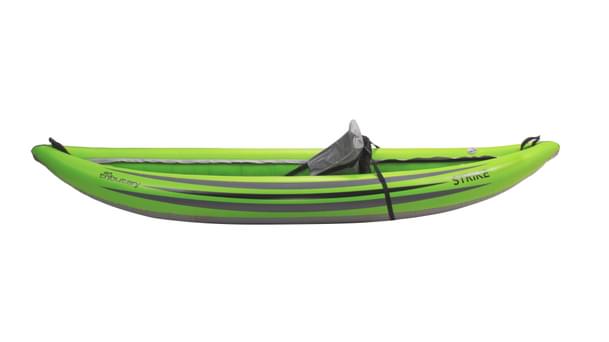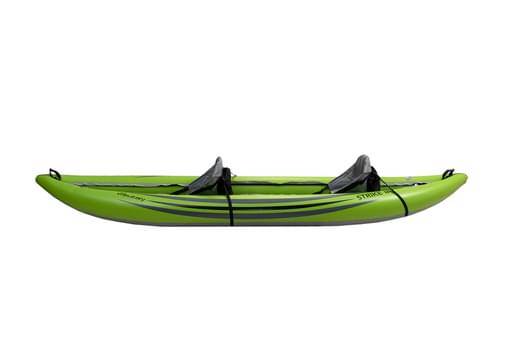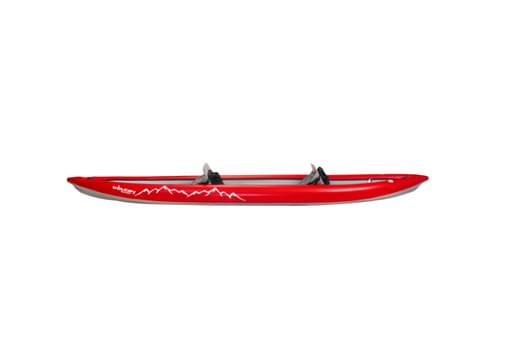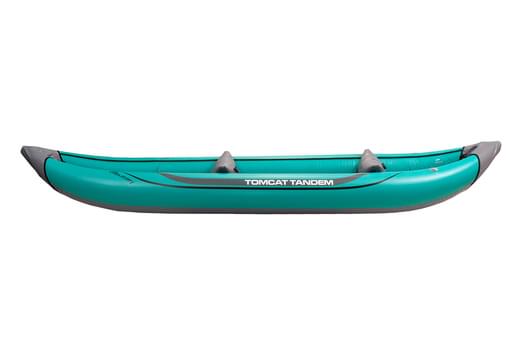- Home
- Gear & Reviews
- Traveller
Traveller

This Product Has Been Discontinued
Traveller Description
The Traveller is a kayak brought to you by INNOVA Kayak. Read Traveller reviews or submit your own review to share with the paddling community. Check out a few other kayak recommendations below or explore all kayaks to find the perfect one for you!
INNOVA Kayak
Traveller Reviews
Read reviews for the Traveller by INNOVA Kayak as submitted by your fellow paddlers. All of the reviews are created and written by paddlers like you, so be sure to submit your own review and be part of the community!
The Innova Traveller was…
Open-decked self-bailing kayaks carry a volume of water with them in rough conditions and this makes them sluggish compared to the Traveler. The Traveller is quite maneuverable but tippy compared to self-bailing duckies like the AIRE Lynx.
It's not a kayak that I would recommend to a new paddler. However, in the hands of a whitewater kayaker, the Traveller is amazing in technical conditions, and a team of Czechs took Travellers down the Zambezi River. I have seen paddlers Eskimo roll the Traveller using a "hand roll" without a paddle. Because it vaguely resembles a sea kayak with its deck and cockpit, some people have thought that touring is its main purpose. Instead, the Traveller should be thought of as a special purpose whitewater kayak. Whereas a duckie paddles like a mini-raft, the Traveller paddles like a portable whitewater slalom kayak.
I'm back for another Innova Traveller review. Readers be advised that my…
Readers be advised that my rating on this boat is based upon my modifications for properly outfitting the boat as described in this and my previous reviews, so be sure to fully read all of my reviews and be prepared to modify your boat similarly to get your perfect "10" boat. If you want a boat that you do not have to worry about the outfitting, then buy the Innova Safari. However, the Safari can only go into whitewater up to class III, but the Traveller WITH MODIFICATIONS is capable of a better whitewater experience at any level, so read on.
I have now added cockpit rim bracing and rear deck padding to firm up the Traveller, adding a wealth of rigidity and capability. To make the modification, cut a piece of firm plastic 3/8"-1/2" thick to match the area of "floppy fabric" just behind the inflatable front deck. Cut and shape to match the area from just behind the inflatable area to just behind the front of the cockpit rim. Once shaped, take some 1" thick closed cell ethafoam, cut it to fit the entire "floppy fabric" area from just behind the inflatable portion of the deck to the widest part of the cockpit rim (skirt coaming). Cut a slit in the foam in the area where your plastic brace is, making the foam 1/2" thick above and below the area of the brace. You're going to make a plastic/foam "sandwich". Coat the brace and the inside area of the foam with contact cement and allow to dry. Slide the plastic brace into the ethafoam slit and press the foam onto the brace to complete the bond. You should now have a firm plastic brace/foam "sandwich" package that conforms to the "floppy fabric" area and looks somewhat like a "C". Email me if you'd like for me to send you some pics, as I took many while making the modification. Optionally, you can add a second layer of plastic to the center of the brace to add additional rigidity, put on a "D" ring to hold your car keys or other small item (I did). Of course you'll need to screw the two pieces of plastic together. Check your brace for alignment and comfort inside the boat. Once satisfied that the brace is firm enough and comfortable enough, paint the "floppy fabric" area where the brace will reside liberally with contact cement. Also, paint the top of the brace. Once dry, insert the brace and press the boat fabric onto the foam/plastic sandwich. Run a screw from the front tip of the cockpit coaming (the gray semirigid strip where you secure your spray skirt)into the brace to secure the center of the brace to the cockpit rim. You may want to put in more screws as you see fit. You should now have a very firm brace to hipsnap against and the boat will feel much more like a hardshell creek boat.
To firm up the rear area without adding much bulk, I found that you can contact cement a cheap foam pool noodle to each side of the rear compartment. Lightly pump up the boat and cut the foam to fit in the area where the top of the sidetube and the rear deck material are joined. When you press the foam noodle into this area, you will instantly see the rear deck lift and firm up. You can also run the noodle on up to join with the rear of your plastic brace. If you do this, the noodle will protrude slightly into the cockpit area, but it will make the skirt coaming very firm, firm enough to place your body weight against it without deforming it. Choose how much noodle you want, trim it up, and contact cement it into the boat. You only need to put contact cement on the 1/2 circumference of the noodle that will be glued into the boat. Be advised that the more noodle you use, the sizier the boat will be when packed.
Speaking of that, I was hoping that my modified boat would fit in the manufacturer's backpack when the modifications were complete, but the boat was a tight fit straight from the factory, and the modifications made it an impossible fit. In order to "fix" that problem, I cut the backpack straight down the back and sewed a 6" wide strip of vinyl material in the back to widen the backpack. Now, the modified boat fits in just fine and is much easier to get in and out than the original outfitting was. Now, for the paddling experience. Be forwarned that the paddling capability described below is for a Traveller that has been modified as described in these (jeremy) reviews including aftermarket footbraces, aftermarket neoprene skirt, a homemade plastic/foam deck/cockpit rim brace, and additional foam in the rear deck.
With these modifications, the Traveller goes from a "this is no fun" boat to the BEST WHITEWATER INFLATABLE EXPERIENCE ever! The Traveller without these modifications only GENEROUSLY musters an "8" at best and I would NEVER take it into serious whitewater. My Aire Force XL now takes a back seat to the MODIFIED Traveller. My Innova Safari also takes a back seat.
I took the MODIFIED Traveller down Tennessee Laurel creek (TN/VA) this past weekend. The Tennessee Laurel is a creek with 80ft/mile gradient that is rarely run due to fast runoff and near flood level water requirements. We have had lots of rain, and the little stream was moving nicely. The stream consists of continuous Class III with one Class IV rapid occurring at the TN/VA state line. The MODIFIED Traveller performed flawlessly with the firmed up deck providing lots of control and the boat feeling very much like a warm, comfortable hard shell kayak without all of the harsh rock impacts. The boat surfed marvelously, boofed marvelously, and had fantastic control, good stability, and good j- leaning and carving capability. The Class IV rapid was ran without incident although admittedly I paddled a terrible line. Control through the rapid was never in question, the MODIFIED Traveller, like the Safari, goes where you paddle it, not where the current takes you. The Class IV State Line rapid consists of an entrance rapid, and three 4' drops in an "S" turn with a nasty hole in the second drop. My buddy in his Aire Force XL got trashed bad in the first drop and swam through the next two. He didn't recover for our planned trip down Whitetop Laurel the following day.
I was amazed at the capability of the MODIFIED Traveller and consistently took the most outrageous lines through each rapid. The MODIFIED Traveller punches through holes instead of getting swallowed up like other inflatables and feels just like a hardshell in running rapids and surfing holes. I was also able to test the boat for wrapping around a rock (to a point). Funny thing is, when the MODIFIED boat begins to wrap, the cockpit actually opens up and your knees naturally pop out. The plastic brace makes the cockpit coaming stretch FORWARD, making MORE ROOM to escape the boat in a wrap. The only real entrapment risk then comes from "tacoing" the boat. Most "tacoing" is temporary, coming immediately after a steep drop on impact with a rock. I didn't experience any "tacoing" with this boat as it is much more rigid after these modifications, and is infinitely more rigid than any open inflatable. A side benefit to the plastic brace is that in the event that the deck loses air, there is little disadvantage. Without the brace, the disadvantage is obvious.
I heartily recommend the MODIFIED Traveller, now that these modifications have been made. The modifications (not including the neoprene skirt) costs under $50 for foot braces, a piece of plastic, a screw or two, some closed cell foam, and a couple of pool noodles. These materials and some of your time can transform the Traveller into the best whitewater inflatable boat you can own for a reasonable price. Yes, the Grabner Jump and the Incept Sally do exist, but the price tag will knock the wind out of you faster than entrapment. Remember, Class IV/V whitewater should only be attempted by those with experience not only in whitewater, but also with the boat they intend to use.
This boat AS OUTFITTED BY THE FACTORY I DO NOT recommended for use on strong whitewater. After making sufficient modifications however, the boat is a whitewater delight. Be advised that whitewater paddling IS INHERENTLY RISKY, and I assume NO RESPONSIBILITY for any of my statements here. IT IS ALWAYS THE PADDLER'S RESPONSIBILITY to ENSURE THE SAFETY of his/her equipment, skill level, ability for self-rescue, and peers' ability to rescue your sorry tail in the event that you find yourself over your head. Never paddle alone and always send out a "probe" (newbie who'll try anything) prior to running the really rough stuff (just kidding) I'll report back when I get to check out the "rollability" of the boat. Tennessee Laurel wasn't the place to roll considering the water was coming from melting snow and the stream bed was strewn continuously with rocks. By the way, the Traveller stock seat seems to work just fine. Just be sure to push the plug in firmly because if you lose seat pressure, you will not have a good day on the water. Happy Paddling. Get out there now, quit reading and paddle!
Paddlers, just yesterday…
The Traveller has a very shallow draft and I was able to navigate shallow rocky water that my friend in his Aire Force XL was hanging up on. The Traveller is quite stable, fast, and maneuverable. It punches through rapids like no open inflatable can, and keeps the paddler warm in frigid water. I found myself pushing the envelope very quickly, taking the most aggressive lines at each rapid, and having a blast. My friend in his open Aire kayak complained of a cold lower section even though he was wearing a full length wetsuit. I was only wearing a farmer john type with exposed legs and arms and was still warm. I am now thrilled with the Traveller.
The only problem that I had in Class III was in surfing the boat sideways. I did not have thigh straps (they are not suited well to the design), and the deck material surrounding my knees around the cockpit rim was too floppy to hip snap with sufficient force to keep the bow from submerging in a surf. The boat was also twisting in response to the force of the water. In short, the boat is now a fantastic whitewater river running boat, but as a playboat it needs to be stiffer. I really don't think that adding the thigh straps back is the answer because they just don't provide any significant improvement to the hip snap force. I am instead going to proceed with stiffening the area around the cockpit rim. I intend to cut a piece of plastic tuffak to fit around the front of the cockpit rim where my knees contact the deck. I will fit the plastic brace, then use contact cement to attach it to the bottom of the deck surrounding the cockpit rim. This will provide a brace where it is most needed to improve the rigidity of the boat. I will then attach 1" ethafoam to the bottom of the brace for comfort against my thigh/knees. If the brace works well, I will attach it permanently with screws through the cockpit rim (uninflated area of unreinforced fabric around the front of the cockpit area where the skirt seal is).
Although I didn't have any problem with the skirt coming loose in rapids, the rear part of the deck has no rigidity at all, being only a floppy piece of fabric. I found years ago that the rigidity of the Innova Junior could be increased dramatically just by pasting 1" ethafoam to the floor and deck material and I intend to look into a similar option for the Traveller. My goal here is to make modifications which will increase lateral rigidity without compromising the ability to pack the boat into its backpack when uninflated. An inflatable kayak can never be as rigid as a hardshell, but paddlers can certainly make improvements to the boats that make them come closer. A more rigid Traveller is also a much safer Traveller, adding paddler control and reducing possibility of hull collapse in a wrap, so keep that in mind.
I now equally enjoy my Traveller as much as I enjoy my Safari, but the rating on this boat will remain the same, because boats should not have to be modified by the owner to meet the requirements specification advertised by the vendor. In the case of the Traveller, use in Class III,IV or V whitewater requires significant modification by the owner, with more modifications and additional skill required for more intense whitewater. Although I would rate my modified Traveller as a 9.5 now, the boat as outfitted by the manufacturer generously keeps an 8 with a warning that it really should not be used in strong whitewater without modification.
My personal whitewater recommendations for the Traveller are as follows:
Class I/II - No modifications required, but Class III modifications HIGHLY recommended as the modifications add to the value of the boat in areas of comfort, safety, and enjoyment.
Class III River Running- Modifications required include Neoprene Sprayskirt and Plastic Rail Type Footbrace kit. Jettison the manufacturer supplied footbrace, thighstraps, and skirt.
Class III River Playing (surfing) and Class IV River Running - All Class III modifications listed above plus cockpit rim stiffening measures.
Class IV Playing / Class V River Running - All modifications listed plus additional stiffening measures including ethafoam and use of float bags in the rear compartment/deck. Sufficient whitewater experience and ability to perform eskimo roll with this boat a prerequisite. Acceptance of the fact that a wrap around a rock or encounter with undercut/strainer could lead to entrapment and death.
I have not personally paddled my Traveller on Class IV yet, but I intend to after stiffening measures are taken and I verify that Class III surfs are easier. The river of choice will be the Nolichucky Gorge (NC/TN) or the Doe River Gorge (TN). All boats either hardshell or inflatable are at risk for entrapment, but the risk is higher with a decked inflatable, so take all possible precautions in hazard avoidance and stiffen up the equipment.
I will return with another Traveller review after stiffening the cockpit rim, mastering Class III, and trying Class IV, so keep an eye out for the next review.
I got the Traveller out and…
My first impression of this boat was one of astonishment and confusion. Even though this boat has a hull identical to the Safari, the paddling characteristics are dramatically different. The first major change is in stability. The Traveller is VERY stable in comparison to the Safari. This is due to the fact that the floor is thinner (not self bailing), so your center of gravity is much lower. So low, in fact, that you are sitting either right at or just below the water line.
There was so much stability that it felt much like my old Aire Lynx with a little more leaning and carving agility. This is actually a good thing as it instills confidence, but only to a point. You reach a point where a boat has so much stability, that the boat loses its leaning and carving capability and becomes a dull barge like the multitude of white water "duckies" on the market. The Traveller is a good compromise for its higher class IV water rating, keeping some leaning and carving capability while increasing stability. Sitting so low in the boat also made it feel just like my old Eskimo hardshell playboat.
The combination of low seating position, closed design, and foreign feel INITIALLY made the boat feel slower and less fun than my Safari, this was not the Love at First Paddle Stroke that I felt when I bought my Safari. This was because my typical paddling angles were way off, and I was getting less "bite" on the water with each paddle stroke. I quickly found also that my legs were getting numb from being locked in the boat and I had forgotten to pump up the foot brace, so I kept sliding down into the boat, frustrating paddle strokes and making the whole experience feel unsafe. After a good 130 minutes of paddling though, I was able to get used to the boat enough to figure out that I had the boat outfitted all wrong, and, more importantly, Innova has the boat outfitted all wrong out of the box. The Innova Safari is perfectly outfitted, straight out of the box. The Safari is a delight to paddle after getting used to it's "tippiness" which is what makes the Safari such a delight anyway, with its amazing carving and leaning capability. After enjoying my Safari so much without any alterations, I was spoiled enough to think that the Traveller would be equally well outfitted without alterations. I was wrong.
Here are the problems that I encountered in my first adventure and how I intend to modify the boat to fix them. First, I'd like to say that the Innova Traveller is a very well constructed and beautiful boat, like all Innovas. After getting the outfitting right, I really believe that it could very well be a favorite. It does have SO MUCH STABILITY that I now question whether eskimo rolls will be possible. I did not try to roll it due to the frigid water temperature. Speaking of temperature, the Traveller is VERY warm and comfortable to paddle. I paddled comfortably in 48F weather with equivalently cold water temperature using a very thin spring wetsuit with no arm or leg covering other than a light vinyl jacket and light "parachute" pants, and wet suit booties. Water did not enter the boat during the entire trip. Some puddling occurs around the sprayskirt, but that's it.
Now, for the outfitting problems... this boat is not properly outfitted right out of the box like the Safari is. The worst offense is the lousy nylon spray skirt that comes with the boat. Jettison it right away and get one made from neoprene with an elastic band size 1.2 like I mentioned in my previous review. This is the NUMBER ONE mandatory improvement to be made immediately. I bought a Seal brand skirt for $125. Also, I found that the thigh braces that Innova supplies for the boat are useless, constantly sliding up my knees, more of an irritation and a source for entrapment than anything else. Jettison them. They are totally unnecessary in this boat, so do not replace them with any other thigh straps. Innova also gets a gold medal for the worst foot brace ever. What works beautifully for the Safari is totally inappropriate for the Traveller, both the thigh straps and the foot brace. The foot brace represents not only a major annoyance in installation and inflation, but delivers very poorly on bracing, being too soft, and also increases entrapment risk because your foot can slide right over the top of it, pinning your foot between the brace and the deck. Jettison it.
Now for the good news... Innova has a perfect installation point designed in for a rail-type plastic foot brace kit. Harmony, Carlisle, Aire, and I'm sure many other manufacturers offer acceptable kits. I selected a Harmony kit based on its low price and slimline design ($28 including shipping) and its currently en route. Anyhow, foot bracing is the NUMBER TWO necessary, mandatory, and immediate improvement that needs to be made to this boat. Install the rail foot brace in the un-inflated material area at the top of the side tubes where the inflatable deck and side tubes are joined. Sit in the kayak and jam your toes into this interface with your heels together (i.e. make a "V" with your feet) to find out exactly where to install the rails. Install the rails where the middle of the rail touches the back of your toes. This will allow both forward and backward adjustment of the pedals. The best part of jettisoning the lousy inflatable footbrace is that you can stretch out your legs so they wont go numb. The best part of my little Class I/II trip was stretching out and leaning all the way back in the boat watching the sky as I floated along the flatwater sections. Very relaxing. But, be advised, you HAVE TO INSTALL A FOOTBRACE. This is mandatory. You cannot paddle this boat effectively without a foot brace. Without foot bracing, you will not enjoy paddling this boat at all. You simply cannot sit up at the proper angle without foot bracing. Your body will slide down into the boat, you will have no "bite" on the water with your paddlestrokes and your back will quickly tire. The seat offers no back support, so your feet support your body and your back, which is what makes the foot brace mandatory. If you want to experiment with replacement seating, do it before you install your foot braces, and be sure to try out your modifications ON THE WATER to make sure you like it before making any permanent alterations. Changing seats will also change your center of gravity and alter the handling characteristics of the boat. I will try my Safari seat in the boat and report back, but I think that the current seat is appropriate as long as eskimo rolls are possible. If I can't roll it though, I may look into replacing it with a seat offering more back support. Installing plastic rail foot braces may void your warranty with Innova because you'll have to punch holes in the material to mount the brace kit, so check it out if you care. I don't really care. For me, the alteration is a requirement to make this boat actually work, and the boat is useless to me without the modification.
I can't help but think that if I figured out the problems with the outfitting in just a few hours, why didn't Innova? I challenge them to reevaluate the outfitting of this boat, save the cost of the skirt, thigh straps, and inflatable foot brace and install a reasonable and necessary plastic rail type foot brace. Make a decent neoprene skirt an option if not included in the price. Getting the outfitting right up front is the first step in increasing customer satisfaction and increasing sales of this boat.
I hope this review has been helpful to everyone considering this boat. Again, the boat itself is well built and has lots of promise. But, until I get the outfitting correct and until the whitewater streams get some flow in them, I'll not be able to give a good whitewater performance review. But, spring is right around the corner, and I'll be back to give you the conclusion to this saga.
Alrighty then. Here we are…
Wow, looks really neat! The boat packs up nicely, but is a tad larger and heavier than the Innova Safari (my favorite boat! see my reviews on it!). The Traveller is essentially a decked version of the Safari and has an identical hull to the Safari with the exception of the bail holes which are of course missing on the Traveller by design. Just this fact means that the rating on this boat has to start at 8 without even a single paddle stroke!
Now, I'm incredibly cheap and I would not pay list for this boat, it's just so much more than the Safari in price, and I could not justify it. Having said that, I also have to say that even at list price it is the least expensive quality decked inflatable on the market and the most accessible. The Incept Sally and the Grabner Jump are both many multiple times the price. Because of the price, the Traveler is also more of a safety compromise, having a smaller cockpit opening and being quite a bit softer (based on pump-up pressures, not experience) which does lend some credit to theories of entrapment during a wrap in whitewater. But, paddling is inherently risky, and the buoyancy of a decked inflatable design should mitigate some of the entrapment risk.
- Now, for some quality "issues".
- The spray skirt that comes with the Traveller is a nylon type that is unsuitable for heavy whitewater use. Innova should save the cost of this item and not include a skirt at all. Be prepared to purchase a 1.2 opening size quality neoprene elastic sprayskirt in addition to the boat.
- Innova drilled holes in the bow and stern for carry handles. These were not sealed up to prevent water entry and may allow some water in the boat during surfing. This can easily be rectified with some caulk or patch if you notice a problem with water entry.
- There is no seat, only a backrest. You sit directly on the floor which is pumped up hard. It is noticeably more uncomfortable than the Safari seat. Soften it up by gluing on a nice piece of neoprene to the seat area or pad your bum.
This being the case, I intend to paddle the boat shortly and provide a review here. I expect the boat to paddle better, surf better, and be more stable and faster than the Safari because the floor is 2" thinner, the center of gravity is lower, and there is no drag or water weight added to the hull from self-bailing holes. I also expect to be drier, recover quicker and be able to run larger and stickier holes than the Safari can due to its closed design. Innova's water rating (Class IV) justifies these expectations since the Safari is rated for Class III whitewater.
I'll provide the paddling review when I've done the paddling, but for those of you who may be tempted by the current sale price of the Traveller, I have no real bad news to offer. The build quality of this boat is exceptional, you feel locked into the boat just as firmly as a hardshell (the thigh straps are actually kind of redundant), but you can easily exit. You can hip snap like nobody's business and this boat responds, I fully expect that it will execute eskimo rolls. And, last but not least, every paddler who sees you with your performance boat in a pack on your back goes... WOW! AWESOME! I'll be back later with the MUCH NEEDED paddling review on this boat.
In the meantime, be sure to read Innova Safari reviews (this boat has the same hull) and factor in your need for a decked boat that adds some bulk (30lbs to the Safari's 24lbs) to your decision. If you already own a Safari, this is a good cold water addition. If you already have a hard shell, this is a good travel companion. If you own no boat at all, I'd wait for my paddling review before committing to the Traveller or buy a Safari if you can't wait. I expect to paddle the Traveller when the ice breaks up and the water rises, so keep your eyes out for more.




